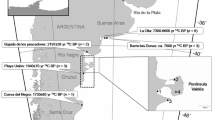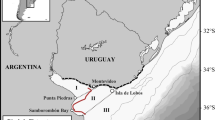Abstract
We investigated the impact of foraging location (nearshore vs offshore) and foraging latitude (high vs middle) on the carbon (δ13C) and nitrogen (δ15N) isotope compositions of bone collagen of northern fur seals (Callorhinus ursinus), harbor seals (Phoca vitulina), California sea lions (Zalophus californianus), and northern elephant seals (Mirounga angustirostris). Nearshore-foraging harbor seals from California had δ13C values 2.0‰ higher than female northern elephant seals foraging offshore at similar latitudes. Likewise, nearshore-foraging harbor seals from Alaska had values 1.7‰ higher than male northern fur seals, which forage offshore at high latitudes. Middle-latitude pinnipeds foraging in either the nearshore or offshore were 13C enriched by ∼1.0‰ over similar populations from high latitudes. Male northern elephant seals migrate between middle and high latitudes, but they had δ13C values similar to high-latitude, nearshore foragers. Female northern fur seal δ13C values were intermediate between those of high- and middle-latitude offshore foragers, reflecting their migration between high- and middle-latitude waters. The δ13C values of California sea lions were intermediate between nearshore- and offshore-foraging pinnipeds at middle latitudes, yet there was no observational support for the suggestion that they use offshore food webs. We suggest that their “intermediate” values reflect migration between highly productive and less-productive, nearshore ecosystems on the Pacific coasts of California and Mexico. The relative uniformity among all of these pinnipeds in δ15N values, which are strongly sensitive to trophic level, reveals that the carbon isotope patterns result from differences in the δ13C of organic carbon at the base of the food web, rather than differences in trophic structure, among these regions. Finally, the magnitude and direction of the observed nearshore-offshore and high-to middle-latitude differences in δ13C values suggest that these gradients may chiefly reflect differences in rates and magnitudes of phytoplankton production as well as the δ13C value of inorganic carbon available for photosynthesis, rather than the input of 13C-enriched macroalgal carbon to nearshore food webs.
Similar content being viewed by others
Author information
Authors and Affiliations
Additional information
Received: 8 September 1998 / Accepted: 24 February 1999
Rights and permissions
About this article
Cite this article
Burton, R., Koch, P. Isotopic tracking of foraging and long-distance migration in northeastern Pacific pinnipeds. Oecologia 119, 578–585 (1999). https://doi.org/10.1007/s004420050822
Issue Date:
DOI: https://doi.org/10.1007/s004420050822




